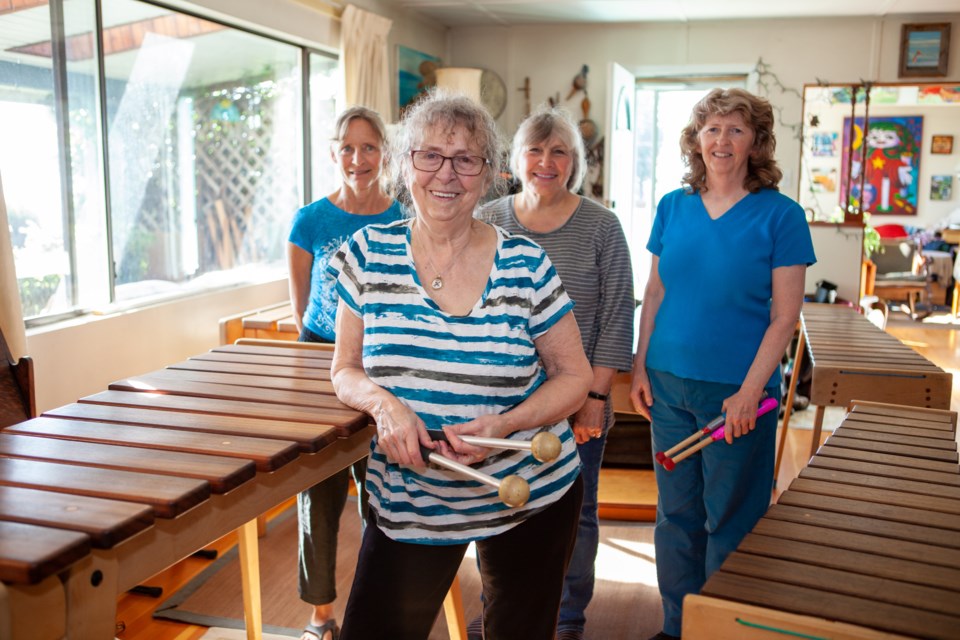Sunlight streams across the promenade at Davis Bay. Its reflections play on the walls of a parlour patchworked in paintings by Sunshine Coast artists. Flowing from open windows, the ricochet of mallets on hardwood punctuates the chorus of passing cars.
Linda Williams is in motion. The septuagenarian community organizer is coaxing rhythm from the largest of four marimbas in her living room. Other members of the Knotty Dotters, a six-woman ensemble, add earthy syncopation on Zimbabwean marimbas, a djembe drum, and hosho rattles. Their eyes are shut. There’s no sheet music.
“It’s all in your head and in your heart and then it’s in your body,” says Williams. “You know, that’s where a lot of this is. In the Balkan stuff, you have to learn those words, but the rhythms and the feel come from your body.”
The “Balkan stuff” took shape a quarter-century ago as another musical passion project. Williams founded the Sokole Balkan Singers following her move to the Sunshine Coast. Today, she is still the group’s musical director and a mainstay vocalist. Both it and the Knotty Dotters Marimba Band perform regularly at local festivals and coffee houses.
Williams’s zeal for Balkan musical traditions was piqued in the 1980s, at the same time that she was a parttime tai chi instructor at the former Oakalla prison farm. Meanwhile, she was working to expand the Vancouver Jazz Festival and booking gigs for a burgeoning corps of expatriate Brazilian musicians.
“I’ve volunteered all my life,” recalls Williams. When her two children were in school, she carved out time from daily duties at the family’s goat dairy in Abbotsford and full-time work at a newspaper office.
In the Fraser Valley, she oversaw May Day celebrations and organized a 7,000-delegate marching band festival. Her talent for promoting arts events was born early and remains undimmed. “I don’t know where it comes from,” she says. “It’s not like it’s in my blood either, because none of my family has ever done that kind of thing.”
In 1990, Williams purchased a house in Roberts Creek. Its bare rooms became the backdrop for communal creativity. “I would bring all my crazy Vancouver friends over and we’d spend the weekend,” she says. “We had no furniture, just milk crates. We’d go to the beach and have everything from theatre and poetry to music all weekend long.”
When she took up full-time residency on the Coast five years later, Williams invested her vigour in emerging arts initiatives. She worked with Gibsons Landing Jazz Festival founder Graham Walker to expand the concert series (rebranded for this year as “Gibsons Landing Jazz Festival—and Beyond”). She met with painter Wendy Charters, together imagining a new organization that would complement the Sunshine Coast Arts Council. It would be a hub, not an umbrella, to support artists through membership-driven leadership. The Coast Cultural Alliance was born.
Williams upgraded her computer programming skills and volunteered to set up the Alliance’s website and database. Today, she still maintains hundreds of artist listings while distributing a weekly newsletter to thousands of subscribers.
Large-scale arts retreats at Camp Malibu in Desolation Sound evolved into programs like the Purple Banner Tour and the annual Sunshine Coast Art Crawl. The first Art Crawl, in 2010, featured 75 studios opened to guests. Last year, 169 participating venues collectively netted more than half a million dollars in sales. The event attracted 38,800 visitors over a single October weekend.
For Williams, who is chair of the Alliance and a board member of the Sunshine Coast Tourism Association, economic viability is the foundation of a flourishing arts community.
“When I apply to local governments for funding,” she says, “I do it under the category of economic development, not under arts and culture. We have all the numbers to show the real value we create. Last year, it was $500,000 going directly to artists. And then everybody knows there’s big spinoffs of that.”
Which brings us back to the marimba band rehearsing by the shores of Davis Bay. The tempo of Williams’s mallets quickens, her hands a blur. Each note rings true. She’s everywhere, all at once.
“When an event ends,” she observes, “everybody says: oh, you must be happy to have a break. But I say, are you kidding? I have even more energy after it’s all over, and feel empowered to do something else.”



